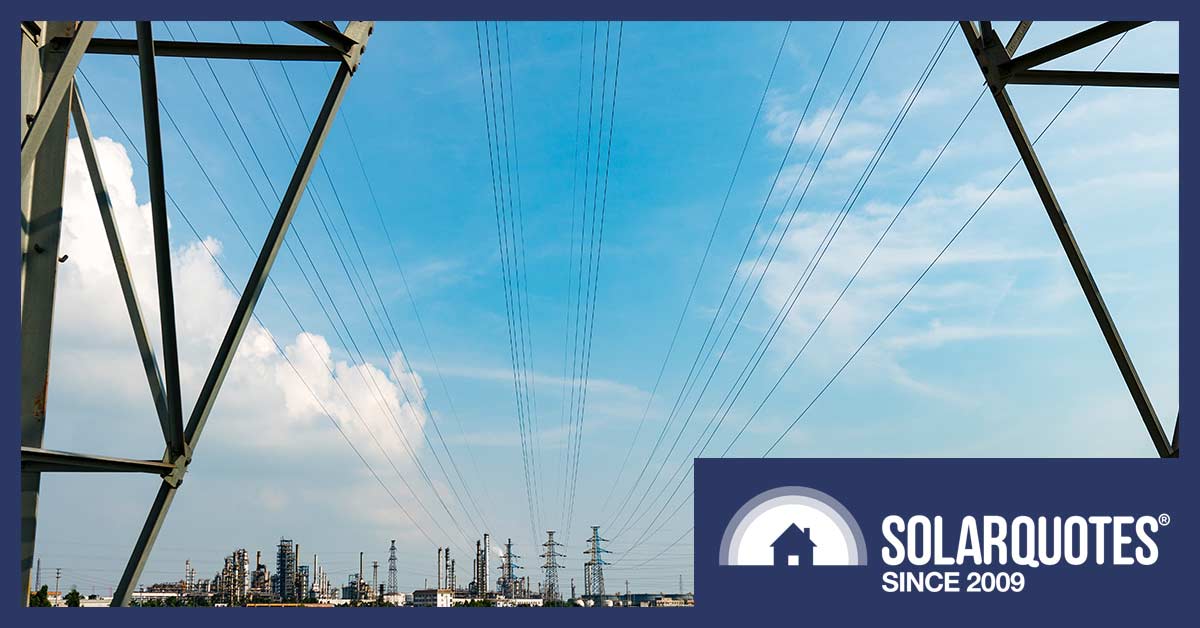
Most Australians were hit with an electricity price increase in July. The exceptions were the ACT, which had a slight decrease, and Victoria whose electricity prices change now in August.
Update August 1st 1:15 pm: I originally wrote that Victorian electricity prices change at the start of the year, but astute commenters have pointed out they now change is August. I have corrected the article.
The good news is, for many, solar feed-in tariffs rose — or at least they should have. Unfortunately, in areas where electricity retailers are not required to pass on increases in the value of daytime electricity through higher feed-in tariffs, Australia’s largest electricity retailers decided not to. In these locations, it will be necessary to shop around for the retail plan that provides the best combination of feed-in tariff and electricity prices.
Any solar household with Australia’s three largest electricity retailers — Origin, AGL, and EnergyAustralia — should shop around to see if they can find a better deal.
In this article, I will tell you…
- How much electricity prices increased in each state and territory in July and Victoria in August…
- How much solar feed-in tariffs have increased — or decreased in the case of Victoria and Western Australia.
This article is not about finding the lowest cost electricity plan, although I have already dropped a hint about some large retailers you may want to avoid.
If you just want the numbers – here they are:
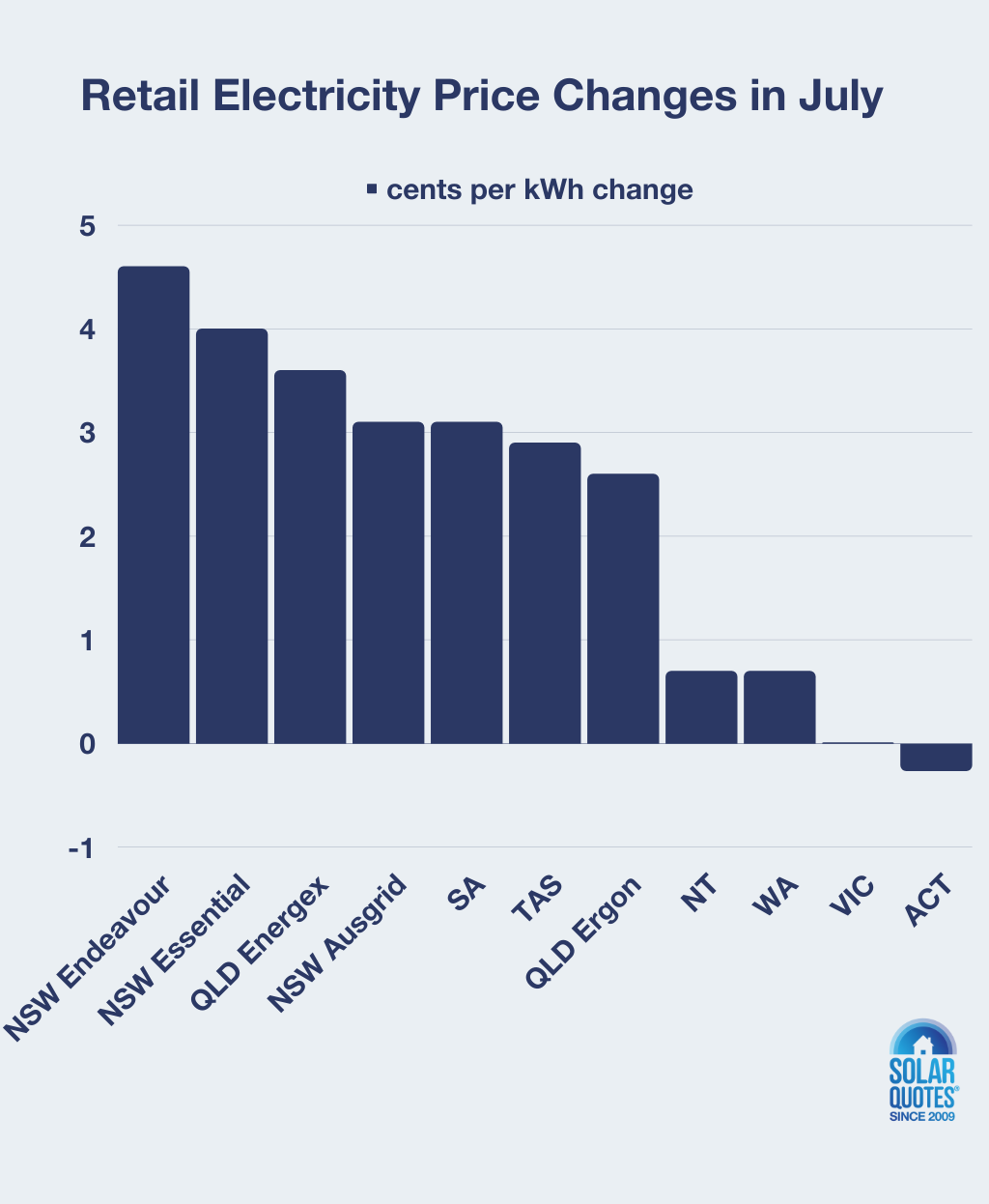
In Victoria there should have been little or no overall change, but depending on area and retailer many Victorians are receiving electricity bill increases form August 1st.
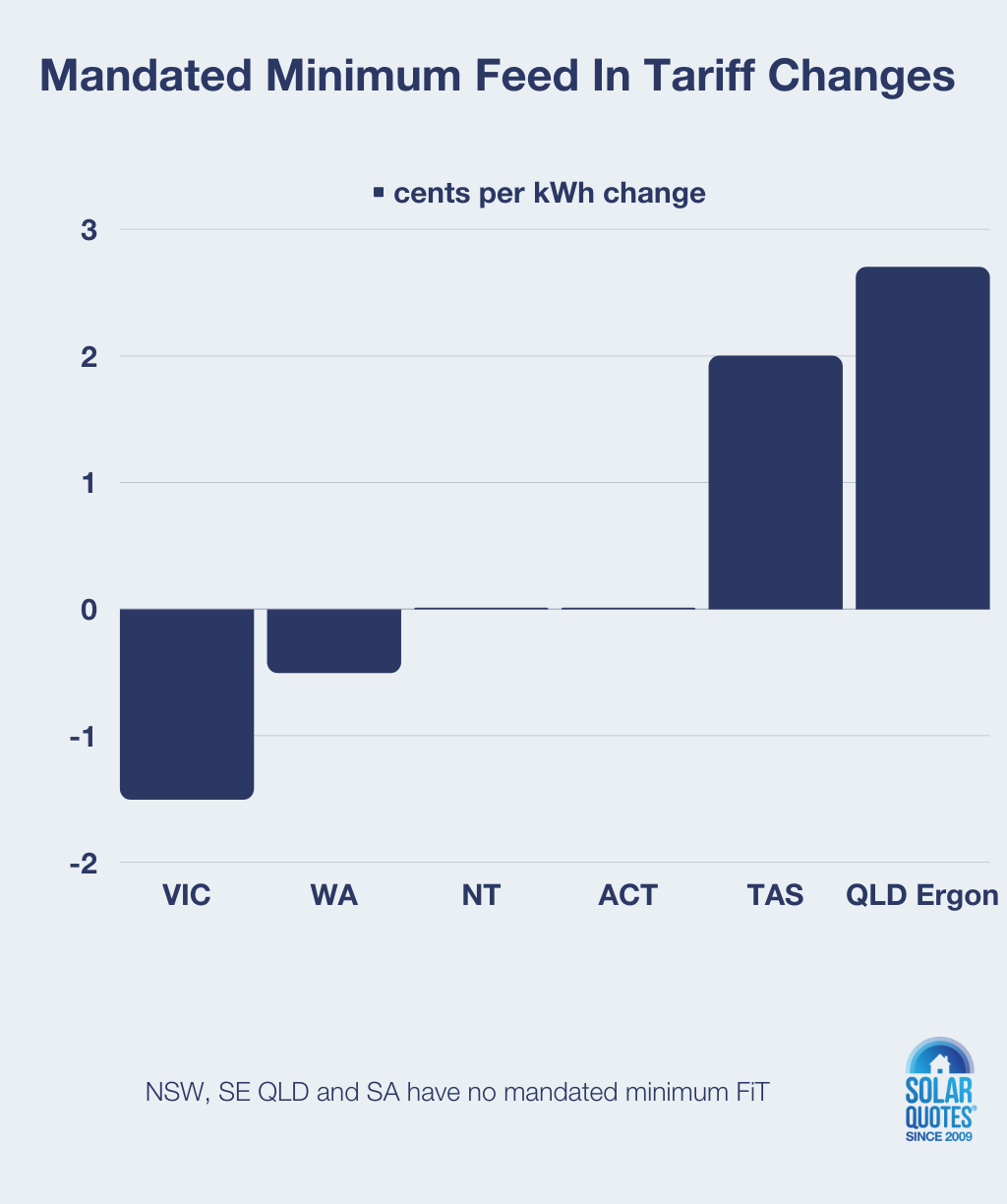
While WA’s feed-in tariff is unchanged from 3pm-9pm, for the rest of the time — which is when most solar energy will be produced — it’s down half a cent from 3 to 2.5 cents.
Why Are Electricity Prices So Damned High?
There are three main reasons electricity prices have risen. One is reasonable, another is aggressively unreasonable, while the final one is stupid but an inevitable result of the way our electricity sector currently works:
- The economy was stronger over the past financial year, which increased electricity demand and increased prices.
- Russia invaded Ukraine, which drove international gas, coal, and oil prices through the roof1.
- Thanks to their decrepit state, coal power stations keep breaking down or being closed for unscheduled maintenance. The most egregious example is a turbine at Queensland’s black coal Callide Power Station that decided to end it all and go out with a bang.
Also, in addition to reasons 1, 2, and 3 — there is also the zeroth reason. The system we have in place allows these costs to be passed on to households, including price increases resulting from a lack of competition, collusion, and gaming the market rules.
While I think it’s (probably) a good thing we make people pay for the grid electricity they use, we shouldn’t forget the way we make them pay is a choice. Other countries do it differently and we used to do it differently ourselves. We do have the option of changing the way the system works and shouldn’t resign ourselves to tolerating evil — even low-grade evil — in the electricity sector.
Unfortunately, we’re on track for even higher electricity prices next financial year. The increases that occurred in July were mostly decided in May. Wholesale electricity prices — what generators are paid for supplying electricity — were up at the start of the calendar year, but they began to soar in April and have been up in the stratosphere for the past three months. If this continues for much longer, we’ll suffer even larger increases next financial year.
I’m happy to call what’s happening with wholesale electricity prices an emergency, but our governments don’t appear to be acting with alacrity2 on the issue.
State Order
Normally, I’d go through the states and territories alphabetically, based on either state or capital names. This is to disguise the fact the best Australian state is the one I happen to be in at any particular time.
I’m not saying I’m that good. I’m just saying my optimism is inversely proportional to the square of the distance.
But this time, I’ll put the often neglected Western Australia first.
I’ll put the even more neglected Northern Territory second, but they deserve to be neglected because they’re so tiny.
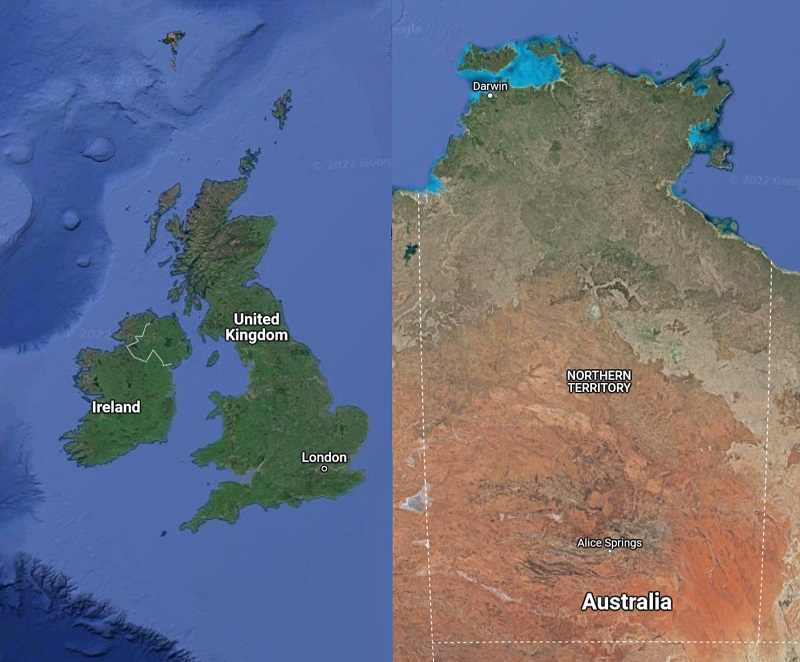
Hardly worth a mention…
WA — Little Change
There has been little change in WA electricity prices. In the Synergy area that has the bulk of the state’s population…
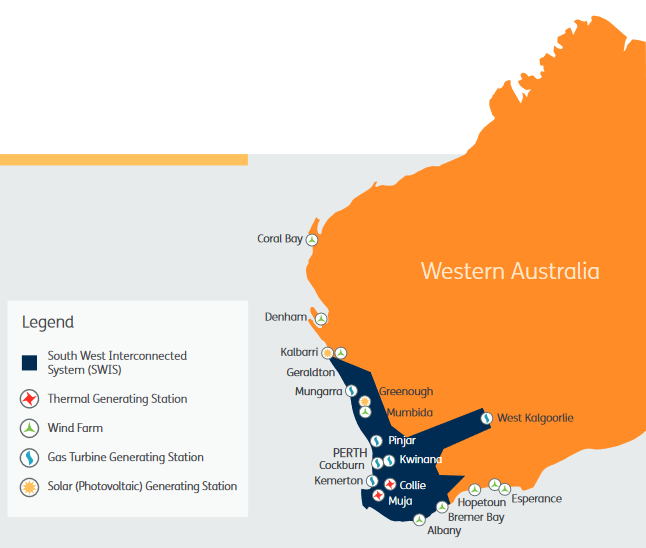
Most Westies dwell within Synergy’s dark blob…
…the electricity price increase has been 0.7 cents per kilowatt-hour.
- Synergy A1 flat tariff before July 1st 2022: 29.33 cents per kWh plus a $1.05 daily supply charge
- Synergy A1 flat tariff from July 1st 2022: 30.06 cents per kWh plus a $1.08 daily supply charge
This was a 2.5% increase in the per kilowatt-hour and daily supply charges. The Synergy time-of-use tariff also received a 2.5% increase across the board. As inflation last financial year was 4.4%3, this means electricity prices have slightly decreased in real terms in WA. Because Western Australians have regularly been screwed over with electricity price increases as the state struggles to pay off debts incurred propping up coal generation, we should all take a moment to appreciate this near miracle. Then we should all immediately weep at what they have done to their solar feed-in tariff.
While the feed-in tariff for electricity exported to the grid from solar panels or batteries from 3 pm to 9 pm remains at 10 cents per kilowatt-hour, at all other times it’s only 2.5 cents instead of the 3 cents it was before July 1st. Cutting solar feed-in tariffs now is blatantly unfair and nuttier than a lumpy chocolate bar stuffed in a squirrel’s larder, given each kilowatt-hour WA doesn’t generate from natural gas frees up around 40 cents worth of gas for export at current international prices. If WA wants to earn money, it should promote rooftop solar rather than stiffing households on feed-in tariffs.
Homes with the older REBS feed-in tariff will continue to receive 7.1 cents per kilowatt-hour. The cut is only for those with DEBS, which applied to new solar installed from August 31st 2020. These people are being punished at a time when their state is benefiting enormously from the clean energy they provide.
NT — Little Change
In the Northern Territory, the flat rate paid by most households increased by 0.7 cents, while the daily supply charge increased by 1.5 cents.
- NT before July 1st 2022: 26.65 cents per kWh plus 52.54 cents daily supply charge
- NT from July 1st 2022: 27.37 cents per kWh plus 53.96 cents daily supply charge
This is a 2.7% increase in the per kilowatt-hour and daily supply charges. This is less than inflation, making NT another place where there has been a decline in electricity prices in real terms.
There has been no change with the current feed-in tariff of 8.3 cents new solar receives in NT, but on July 1st the high premium tariff equal to the cost of grid electricity was removed from those who have had it for four years or more.
ACT — The Only Electricity Price Decrease
As stated here, residents of the ACT received an electricity price decrease on July 1st that will lower their electricity bills by at least 1.25%.
While this only comes to a reduction of around 0.26 cents per kilowatt-hour, it’s impressive they had any reduction. This reduction is thanks to their 100% renewable electricity target, which has helped protect them against wholesale price increases. It also appears to have protected them against feed-in tariff increases, as I can’t find any mention of changes — either up or down.
TAS — Electricity Up 12% Feed-in Tariffs Up 30%
As mentioned here, Tasmania’s Aurora Energy had an 11.88% increase in standing offer prices on July 1st. This comes to a 2.9 cent increase per kilowatt-hour. Other retailers have had similar increases.
The regulated minimum solar feed-in tariff for Tasmania was 6.5 cents last financial year, but on Just 1st it was raised by 2 cents to 8.47 cents. A 30% increase.
QLD Ergon Area — Electricity Up 12% Feed-in Tariffs Up 41%
Electricity price increases have hit Queensland hard, and a considerable part of that was due to a turbine explosion at the Callide coal power station in May last year, causing a shock reduction in electricity supply.
But determining what has happened to average household electricity prices isn’t easy. This is because Queenslanders have electricity retailer choice and pick from a wide range of plans. But in the rural Ergon network area, while there is retailer choice, most homes have remained on Ergon tariffs. These are only supposed only change in line with the cost of supplying electricity, so their increases should reflect the average change for the state.
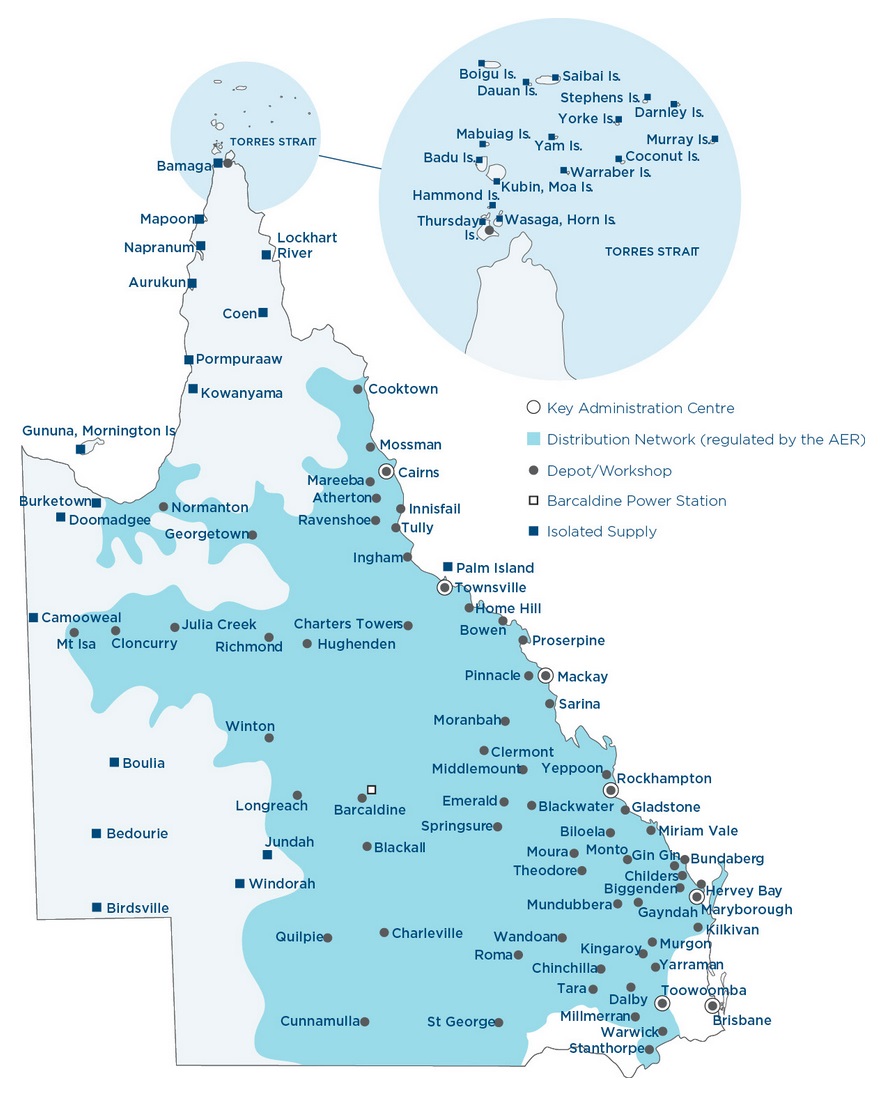
The Ergon network area is one of the largest blobs in the world.
Looking at Ergon’s flat tariff 11, the per kilowatt-hour charge has increased by 2.6 cents:
- Ergon area tariff 11 before July 1st 2022: 21.76 cents per kWh plus 97.23 cents daily supply charge
- Ergon area tariff 11 from July 1st 2022: 24.35 cents per kWh plus 99.45 cents daily supply charge
This is a 12% increase from last financial year for the per kilowatt-hour charge and a 2.3% increase in the supply charge. The 2.6 cent increase in the per kilowatt-hour charge is considerable, but not too bad, given the state’s average wholesale electricity spot price per kilowatt-hour in 2020/21 was 12.2 cents higher than in 2019/20.
Unfortunately, the increases for economy tariffs 31 and 33, which many Queenslanders use for their hot water systems, have been pushed even higher:
- Tariff 31 — supplied for a minimum of 8 hours a day — has increased by 2.9 cents and is now 17.3 cents per kilowatt-hour.
- Tariff 33 — supplied for a minimum of 18 hours a day — has increased by 3.4 cents and is now 19.1 cents per kilowatt-hour.
The solar feed-in tariff in the Ergon area has increased by 2.7 cents:
- Ergon area feed-in tariff 11 before July 1st 2022: 6.58 cents
- Ergon area feed-in tariff 11 from July 1st 2022: 9.3 cents
This is a 41% increase from last financial year.
Now I’ve gotten the tetchy little places out of the way, I can give information on Australia’s best state, which is South Australia on account of how I’m there. But first, I’d better cover a couple of places that I think are important simply because they have populations larger than Latvia.
Default Market Offers — SE QLD, NSW, & SA
For the rest of Australia — SE QLD, NSW, SA, and VIC — I can determine the average electricity price increase from their default market offers. The amount these have increased from last year reflects the increase in the cost of supplying electricity in those areas. Or at least they are supposed to. You can get more details in this difficult-to-read document.
There is no fixed solar feed-in tariff in these areas. Retailers can offer whatever they want, including nothing. Feed-in tariffs should be up because wholesale electricity costs during the day have increased, but retailers don’t have to pass this on. For each area, I checked if Australia’s three largest electricity retailers — Origin, AGL, and EnergyAustralia — increased their feed-in tariffs. None did for the plans I checked.
SE QLD — Electricity Up 11.5%
In South East Queensland’s Energex area, the default market offer is up around 3.6 cents per kilowatt-hour for the typical household. This is an increase of 11.5% and considerably more than the 2.6 cent increase in rural Queensland’s Ergon area.
Prices for controlled loads have increased by slightly more than 3.6 cents.
Looking at feed-in tariffs, I see that Origin’s Solar Boost and AGL’s Solar Saver plans have had no increase and are both 10 cents for the first 14 kilowatt-hours of solar electricity exported each day and 5 cents for the rest. (Yes, it is annoying that they have two rates. It’s also evil, as they intentionally make people’s lives worse by making their plans more confusing.)
EnergyAustralia offers a 6.6 cent feed-in tariff with no increase4.
Hopefully, you’ll find retailers that have increased their solar feed-in tariffs, but Australia’s three largest retailers have not passed on the extra value they have been receiving from household solar exports.
NSW — Electricity Up 8.5% to 14.5%
NSW has three distribution networks, Ausgrid, Endeavour, and Essential:
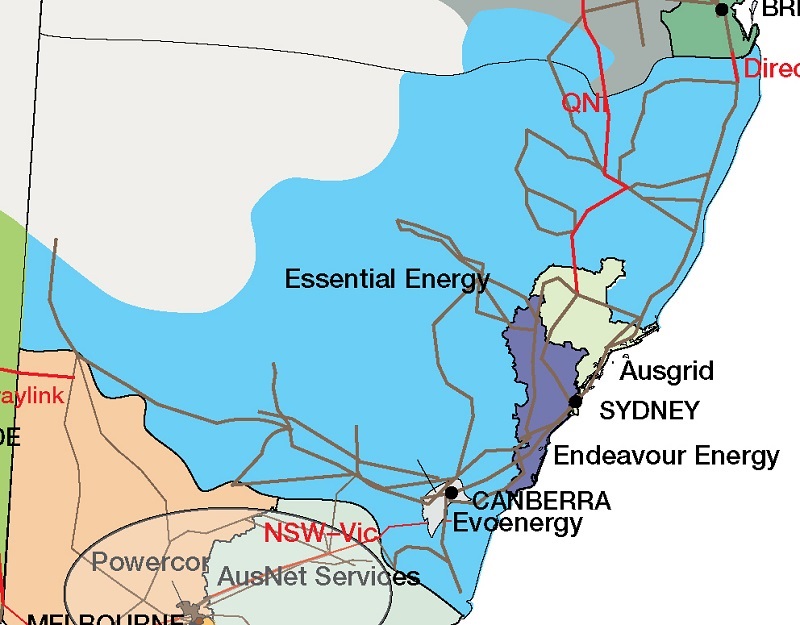
NSW’s three Distributed Network Service Providers. Note Essential’s blob is so large it even extends into Queensland. Also note, Queensland could not give a damn.
The figures given are for households with typical electricity consumption and applies to their general supply. The per kilowatt-hour figures include changes in daily supply charges. The changes in the default market offers for the three NSW distribution areas are:
Ausgrid: An 8.5% increase of 3.1 cents per kilowatt-hour.
Endeavour: A 14.5% increase of 4.6 cents per kilowatt-hour.
Essential: A 9.7% increase of 4 cents per kilowatt-hour.
Controlled loads: In the Essential area, the price of electricity for a controlled load — which is what many hot water systems use — will increase by just under the amount for normal household supply. But in the Ausgrid and Endeavour areas, the increase will be higher than for general supply, making homes with controlled loads even worse off.
Feed-in tariffs: Despite solar exports increasing in value, there has been no increase in solar feed-in tariffs offered by Origin, AGL, or EnergyAustralia.
SA — Electricity Price Up 7.2%
The default market offer in South Australia is up 3.1 cents. This is a 7.2% increase. Unfortunately, the price hike for controlled loads will be even greater.
Unlike in NSW, I found a change in solar feed-in tariffs. Origin decreased theirs:
- Origin’s Solar Boost plan lowered its feed-in tariff. It’s still 10 cents for the first 14 kilowatt-hours a day, but now 5 cents for the rest instead of 6 cents.
- AGL’s Solar Savers plan is still the same at 10 cents for the first 14 kilowatt-hours per day and 5 cents for the rest.
- EnergyAustralia’s feed-in tariff is unchanged at 6.6 cents. (Their Max Solar plan is unchanged at 10 cents, but typically only suitable for small systems. So it’s not really very “Max” is it?)
So in the face of rising daytime wholesale electricity prices, two of the big retailers have failed to raise their feed-in tariffs, and one has lowered them.
Victoria — Electricity Up 5% Minimum Feed-in Tariff Down 23%
Victorian electricity prices change at the start of August, rather than in July. (I originally wrote they change at the start of the calendar. Sorry about that.) It as been reported that Victoria’s default offer will increase by 5%, which is around a 1.1 cent increase per kilowatt-hour. But looking at the changes in the default offers for Victoria’s five electricity distribution areas, it’s more complex and the default offer increase for has been:
AusNet Services: An increase of 0.7 cents per kilowatt-hour and an extra 10 cents to the daily supply charge.
CitiPower: A decrease of 1.5 cents per kilowatt-hour and a decrease of 5 cents to the daily supply charge.
Jemena: A decrease of 1.7 cents per kilowatt-hour and an increase of 8.7 cents to the daily supply charge.
Powercor: A decrease of 0.7 cents per kilowatt-hour and an increase of 4.2 cents to the daily supply charge.
United Energy: A decrease of 1.1 cents per kilowatt-hour and an increase of 4.7 cents to the daily supply charge.
Households in the very small CitiPower are clearly better off and those in the AusNet Services area are clearly worse off, but for the rest it’s difficult to tell, as they have had decreases in per kilowatt-hour charges but increases in daily supply charges. But for a home that consumes 4,000 kilowatt-hours of grid electricity per year, the results are:
- Jemena: About $36 a year better off.
- Powercor: About $13 a year better off.
- United Energy: About $27 a year better off.
This means, overall, there should have been little change in what Victorians pay for electricity. But many Victorians have been hit with price increases today. If this applies to you, I suggest checking to see if you can get a better deal from another retailer — or the same one.
Feed-in Tariffs: Unfortunately, they received a cut in their minimum solar feed-in tariff. It went down 1.5 cents from 6.7 cents to 5.2 cents on July 1st. A 23% decrease.
Winners & Losers — But Mostly Losers
Here’s a summary of electricity price changes. This time I’ll go by state and territory in alphabetical order and give the changes in cents per kilowatt-hour for general supply.
- ACT: down around 0.26 cents
- NSW Ausgrid: up 3.1 cents
- NSW Endeavour: up 4.6 cents
- NSW Essential: up 4 cents
- NT: up 0.7 cents
- QLD Energex: up 3.6 cents
- QLD Ergon: up 2.6 cents
- SA: up 3.1 cents
- TAS: up 2.9 cents
- VIC: ~0 cents overall change
- WA: up 0.7 cents
The NSW Endeavour area has been hit hardest of all. WA and NT got off lightly, while the ACT came out ahead with a cut in electricity charges.
The cost of controlled loads — often used for hot water systems — has increased by more than the amounts above in the QLD Ergon area and the NSW Ausgrid and Endeavour areas.
Solar Feed-in Tariffs — Mostly Up
Changes in fixed and minimum solar feed-in tariffs have been:
- ACT: no change
- NT: no change
- QLD Ergon: up 2.7 cents
- TAS: up 2 cents
- VIC: down 1.5 cents.
- WA: From 9 pm to 3 pm — down 0.5 cents (For those receiving DEBS.)
In the three states without set or minimum feed-in tariffs — South East Queensland, NSW, and SA — solar feed-in tariffs should have increased because the cost of electricity during the day increased. But I’ve found no evidence of Australia’s three largest electricity retailers raising theirs. This does not mean no retailer has increased their feed-in tariffs, but you will need to look around to find the best deal for your situation.
Worse To Come
Unless the current wholesale electricity crisis is rapidly resolved, the rest of the country will be hit with another round of electricity price increases at the start of the next financial year.
This will also increase the value of solar electricity, but as large electricity retailers have reluctant to increase feed-in tariffs, this makes it even more important for many Australians to shop around for the best electricity plans.
(Finn tells me that our re-tooled electricity retailer comparison tool will be ready in mid-August – to help compare usage, feed-in-tariffs and daily charges.)
Footnotes
- Western Australia’s electricity prices were not affected by this, as a portion of their gas production is reserved for domestic use and so didn’t increase in price. Also, their coal is awful unexportable crud and not affected by international prices. ↩
- When words like “alacrity” are used, it usually means someone is trying to call someone else a freaking moron, but in a classy way, ↩
- The RBA figures here, plus the 6.1% figure for the June quarter, average to 4.4% inflation for the last financial year. ↩
- EnergyAustralia has a Solar Max plan with a 10-cent feed-in tariff, but this has not increased and is generally useless for households with more than 5 kilowatts of solar panels. But if your solar self-consumption rate is high — possibly due to having a battery — you may find it worthwhile with a larger solar system. ↩

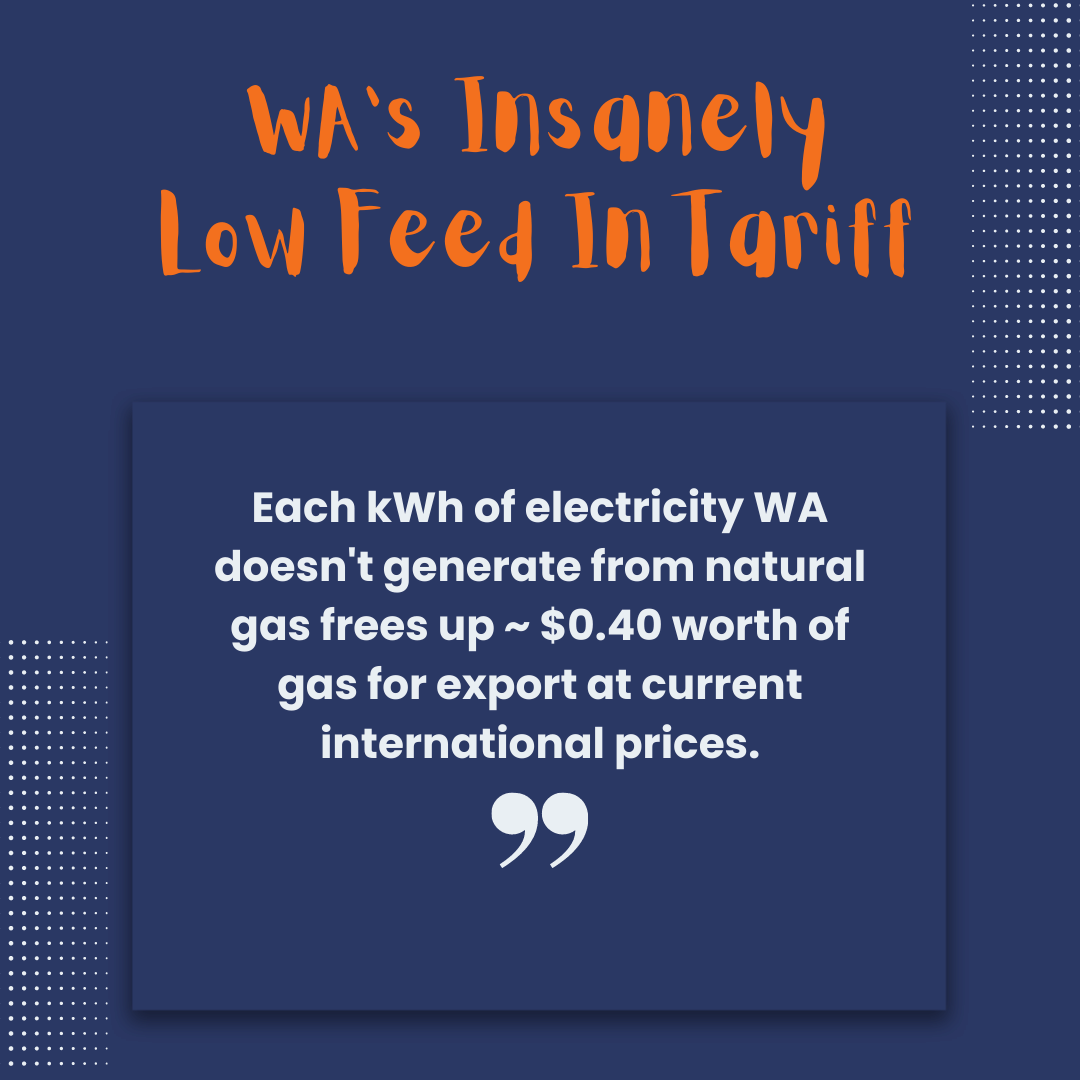
 RSS - Posts
RSS - Posts



Might want to double check Vic electricity changes. Vic fell into line with FY changes. You’ll note most electricity plans change in August each year now 😉
Oops! Yes, I did make a mistake there. They have just gone up. Thanks for pointing it out. I’ve updated the article.
“Because CitiPower and AusNet Services are the same organization but cover two areas, Victoria has four distributors.”
I don’t think they are.
PowerCor, Citipower and United Energy are owned by the same company but Ausnet is seperate.
Oh dear. I think I’ll just remove that footnote, because I don’t want to take the effort of looking into company ownership at the moment. But thank you very much for pointing it out.
Interesting. Victoria did have a lot of price hikes in July though. I know I certainly did.
Vic had record cold. Solar output was also weak in QLD/NSW with the flooding and there were quite a few periods of wind lulls. It’s worth mentioning that as every Wh counts with such a tight grid.
Sorry about that. Vic prices used to increase at the start of the new year, but now they increase in August and the default offer is up 5%. I’ve updated the article. Thanks for pointing it out.
Hi Ronald,
I live in the Essential Network area and am currently with AGL. Not sure how to take your figures. AGL have at least 2 different daily supply charges for my area. The plan I am on appears nowhere on their website. 20C FIT but extortionate TOU rates. Impossible to tell whether better off long term staying with this or changing to a lower FIT plan due to number of cloudy days lowering solar production to a third of normal.Energy Made Easy says change but I think I change inertia.
Dave
were getting ripped off with solar feed in sa ,electricity goes up feed in goes down so they charge us more and pay us less how the hell does that work rip off bastards ,contact local labour mp but no response that was more than a month ago,maybe time contact office of fair trading cause this aint fair trading were getting RIPPED OFF
In Victoria our electricity went up 5% today August 1st. FiT dropped to 5.2c. AGL
Thanks for that. I was behind the times as Victoria now changes their electricity prices now in August. I have updated the article.
Well, one element is incorrect here. Despite the fact that the regulator reduced prices in the ACT, Origin energy still increased my charges by nearly 2.5c/kWh on 1 July, although they did also increase the FiT from 7 to 8 cents. Never stand between a distributor & a chance to rip you off.
I asked Origin the obvious question and am still awaiting a response.
I am in SA with AGL. I have only had my 6.6kw system for two full quarters. I have been able to conduct a full analysis of my 2 past bills, and the result is so disappointing. I have been able to calculate impact their new rates, and going from 12C unrestricted FIT, to the new FIT of 10c for the first 14kWh, and 5c for the balance.
For February to May my AGL bill would drop from a Credit of $89.44 to a credit of $0.56.
For November to February my AGL bill would drop from a Credit of $164.70 to a Credit of $28.17.
The best option I have found to date using the same modelling is SUMO who have lower rates and 8cent FIT. SUMO February to May would be a credit of $21..01. For November to February SUMO would be $72.92 credit.
FYI this is on TOU, as Flat Rate is not allowed by SAPN.
I have noticed SUMO appear to have good rates, but I’m afraid that’s all I know about them.
I haven’t spoken to SUMO yet as my FIT stays at 12C till 12 month anniversary in September. I have tried to contact SUMO by email, but the only contact method other than receiving quotations is by telephone. Badly need some reviews of SUMO. Customer service appears to be restricted to weekdays and closes at 4.30pm assume EST.
Just changed to them, the only complaint I have is that due to the way I got a quote and then signed up I started getting marketing emails to do with my quote until even though I called them up and changed my power over. I think they have now stopped.
I had to give them an authority to direct debit to get the better rates. unfortunately this was only a couple of weeks ago so I have not had any billing cycles with them yet. Good news was they were able to set up the direct debit over the phone with out paperwork.
I have had worse power company’s this far in, if that helps.
Thanks for the info.
I’ve just switched hopefully as of today from OVO. Not the best company to contact though but I’ve had worse. OVO was on the ball but $$. count at this time, so its SUMO for now. Hope they don’t mess up when the billing starts.
I have copied the below chat I had with AGL today. Have not been replied too yet. I am thinking of sending it to other power retailers to see what might happen. One never knows. Unfortunately I don’t use a lot of power bu have pretty good solar exports.
I cannot accept huge increases in hourly rates as well as the the huge reduction in FIT from September. This rubbish has meant that my credit for the last account (Feb to May) would become $0.56 debit and not $89.44 credit. If the 12c FIT is maintained I would have a credit of $76.22.
For November to Feb my credit will drop from $164.70 to a credit of $28.17. If the 12c FIT is maintained my credit will become $141.00.
If I am to stay with AGL I want my FIT to stay at 12c.
An interesting fact about “Default Market Offers” – there is NO publicly available details on what the daily connection fee nor per kWh usage charge for any company’s ‘Default Market Offer’.
I took this up with the ACCC, the AER, AEMO & the Federal Govt Dept responsible for the USELESS & unreliable ‘Energy Comparison Site’.
___________________________________
Pick any power company and try to find what daily connection fee & per kWh grid power cost they used. Contact any of the above Govt Departments and see what happens.
Contact each power company after searching their web sites and you will not find the data. Under the legislation no provider is required to make public how they arrived at the default market offer, let alone provide the actual calculations to verify that what they claim is true.
BTW – On an AGL plan (never shown on Fed Govt site), from Click takeover – FIT unchanged, daily fee up 0.7%, grid kWh up 21.3%. Total bill increase (using last 12 months) = 19.5%
In Ausgrid area, so AGL have added another 1 cents per kWh to the AusGrid increase, making our price increase 4.3 cents per kWh.
Profiteering anyone?
___________________________________
The Fed Govt comparison site is not checked nor validated by any Fed nor State Govt entity. False or plainly incorrect information on it has zero consequences/comeback for any Energy company.
The ACCC refused to do anything despite the fact that I had requested a full digital copy of my phone call to one oft-praised ‘new/smaller’ company where the exec responsible stated that ‘it doesn’t matter if our web site has wrong information – you cannot complain to anybody about it since it is on the Federal Govt energy comparison site.’
I only requested ‘a full digital copy of this phone call, which is your right under the Federal Privacy legislation’, at the end of the conversation. Said exec was quiet for a number of seconds as he took in the consequences.
TRUE. A company can refuse to provide a full digital copy and instead provide a transcript which you can then challenge, & challenge again & then go to mediation & have the phone call played…
Red flag to a bull – so I did attempt to complain, Fed Govt Dept responsible for the site, after a multiple email trail over some weeks I requested a phone call – which happened, speaking to the person ‘responsbile’ for maintaining it – “Not our responsibility. Any complaints are forward to the provider.”
Do you follow up? “No, the provider does.” Or doesn’t as I discovered with 3 separate providers with incorrect/false information.
ACCC – “The Federal Govt would not permit false nor misleading data to be provided on that site, speak to them if you believe so.”
I did & they said ‘not their responsibility. Well I can send you the page links and prove that the Fed Govt does permit this. ACCC words to the effect ‘not our responsibility’.
NSW Fair Trading – “Fed Govt responsibility, we have no powers.”
Hold-on, these are companies operating in & licensed by the NSW State Govt defrauding NSW residents.
“Contact the Federal Govt”.
Then tried several MPs & Senators – most did not reply. The two that did advised to contact ACCC/Fair Trading respectively. Replied that I’d tried – no subsequent response from those MP/Senators.
My experience of a lot of State Commercial legislation as opposed to Criminal, is that it is there for show. I have had experiences in WA, NSW and Tas. There doesn’t appear to be any way much of it is policed.
Furthermore with the last 40+ years of “neo-liberalism” one of its tenets being “small government”. But “None of our front line Staff and Services will be impacted” doesn’t get around the reality that most of this legislation is dealt with by the non “front line staff”. And many of these have been done away with or, even worse been outsourced.
Increases are one thing, but what about a comparison of the variation in current costs of electricity among States? I accept that with the multiplicity of rates and add-on charges it is difficult to establish a benchmark for comparison, but do we have a clear idea whether typical households will pay significantly more or less for their total energy utility bills in 22/23 according to the State they live in? If my memory serves me correctly SA has historically been a high cost state, is this still true despite the smaller increases this year?
Of course, I live in Tasmania, where changes in the price of coal and gas have no impact on generation costs, so any electricity price increases beyond those needed to cover labour and other non-fuel cost increases flow through to the State Government in the form of extra profits for the state owned Hydro Tasmania, so it is swings and roundabouts whether we pay more for our electricity or higher taxes due to a lower Hydro Tasmania dividend.
No mention of the daily service fees? Bit of bracket creep going on there too.
As to electricity demand, overall NEM demand 2021/22 was only 1% higher than 2020/21, while the increase in rooftop solar PV output more than covered that small increase in demand. IOW the supply from grid generators fell slightly last financial year.
For SE QLD, NSW, and SA the increase in daily supply charge for typical households is included in the per kilowatt-hour increase. This is because the default market information for those areas didn’t separate it out. I may have been able to separate it out, but I was too lazy.
I think probably the best indicator is the changes in network pricing of daily network access fees the distributors are billing retailers per customer.
It’s not the retail amount we pay but it definitely sets the tone for the direction and amount retailer daily fees go up. e.g. in my area (Essential Energy NSW) the network daily charges over last few years (incl. GST):
2022/23 – $1.0025
2021/22 – $0.9667
2020/21 – $0.9200
2019/20 – $0.8963
2018/19 – $0.8746
What is the Labour government doing about electricity prices?
So far all i have heard is them talking about new transmission lines, there dose not seem to be any mention of new capacity.
I know a lot of coal power stations are going to start shutting down for good soon, i would have assumed we would want to add extra capacity now for when that happens in the future?
At the moment we have a wholesale electricity price crisis, which I wrote about here:
https://www.solarquotes.com.au/blog/australia-electricity-price-problem/
Today is the first day for months where daytime electricity prices have been more or less normal in the eastern states — with the exception of South Australia.
This doesn’t mean the crisis is over, but hopefully it is easing.
I live in the act and origin tryed to put my prices up by alot aprox arcoss the board. I did get a 1 c inrease on my feedin as well though.
Lucky i only signed up to them in feb so after arguing that they prommised to not charge me more for a year and having to provide them with our contract? They are now not passing on the increases until the contract expires. The whole experiance was pretty dodgy and i wonder how many people agreed to new contracts without checking their protections under the original.
Since I installed my PV system in May 2019 I have had nothing but incompetence and obfuscation, every year from Origin , I live in regional NSW. Every annual negotiation is a hassle.
My take is that when the downward $curve of Battery acquisition intersects with the upward curve of capacity and longevity, I will seriously consider going off grid. Hopefully that isn’t too far into the future.
We are also in regional NSW. We found Origin Energydifficult to deal with when we added more solar panels, so we switched to Red Energy. The AER’s pricing website (https://www.energymadeeasy.gov.au/) showed Red Energy’s prices as more expensive than Origin Energy, but our bills have been way less since switching. I’m not sure the prices for plans on AER’s website are accurate.
Might be worth switching to another retailer until battery storage comes of age
Greetings,
I live in Victoria and have just shifted to a new residence and I am contemplating on getting solar,
Question is it still worth while ,or am i blowing against the wind
It should be worth getting a quote.
You can likely log in to your distributors site to view when you use power. (some retailer also have good portals that allow you to do this)
If you look at any power bills you have that also may give you an idea if you should get solar. If you brought an existing home the sections 32 should have an old bill. Maybe showing monthly power use.
If you are using 10kWh it may not be worth getting solar as the payback will be largely dependent on a good fit.
However if you are using 30kWh a day I would be surprised if solar doesn’t make sense. (Remember solar can only replace grid imports when it’s making power)
A good solar retailer should be able to make some reasonable assumptions and show what the pay back period would likely be.
A crappy one will pretend you will have high self-consumption without any bases and or a large fit that you may not be able to get. (Bad ones are normally lazy)
Hi Ted.
I certainly think solar is worthwhile in Victoria, provided you have an unshaded or mostly unshaded roof. While Victoria’s minimum feed-in tariff was recently reduced, I expect it to increase next year. Even the current minimum is not that bad given the cost of solar and that rooftop solar will also reduce your grid electricity use during the daytime. You can also shop around and potentially find a better feed-in tariff. Victoria still has a $1,400 state rebate available to the majority of households.
If you are just interested in the fasted return you can get quotes through us…
https://www.solarquotes.com.au/quote/start/
…and request a budget system and you will get a well-installed system that uses lower cost, but reliable hardware. We guarantee it:
https://www.solarquotes.com.au/installation-guarantee/
If you are interested in a higher-quality system using more premium hardware, that’s also available.
I used to be with Click Energy for years who had a nice 20c FIT. Click was taken over by AGL who initially honored the 20c FIT. They sneakily reduced this to 5c FIT after a while. I shopped around and found GloBird Energy offering 20c FIT to anyone from NSW, might be worth a look for anyone getting paid low FIT in NSW.
I’m in VIC and my retailer told me that their rates were going up AND my distributer was changing my tariff to remove weekend offpeak from TOD9 (net result 25% increase).
I shopped around and I was able to get a new deal with similar rates, but the tariff changes have meant I still have ~15% increase – due to the extra 12 hours of Peak rates the new tariff has.
I was with Origin, on 16c FIT. In July this reduced to 10c for the first 14kWh, then 5c for the remainder. Prices also increased as stated in the above article. Swapped to GloBird, whose rates were ~ 30% higher than Origin, but offered 20c FIT.
Origin then offered lower rates than my original contract, but only 12c/kWh uncapped. I replied and said not good enough. They came back today with 19c/kWh uncapped and the same low rates.
In summary – it pays to shop around.
Mal, I did a quick Duck for GloBird (I’ve never heard of them before) and they look to be 60.5c per kWh for usage, and only offering 5c per kWh FIT. The government Energy Made Easy website suggests usage fees are even higher.
Interestingly enough the website offers Chinese support – not something I recall seeing before, but it’s mainland only not traditional.
Ronald, I had a crack at your “difficult-to-read” document, and yes, I think interpreting Egyptian hieroglyphics would be easier!
I note that you never mention Lumo Energy in your articles about tariffs, which is a pity as I use them as my retailer in SA. My current feed-in tariff is 11.5 cents per kWh for all export. I have found Lumo to be a dreadful company to deal with, but as far as I can tell their rates are competitive, but I have yet to receive any notification of a change in their tariffs applicable since July. Maybe there is no change to the FIT, controlled load, general usage, or daily supply charge, but I can’t find any info on their website. Are you able to advise of changes? Regards, John K
I’m afraid I don’t know what LUMO is doing, but a quick look online shows they’re currently offering very low 3 cent feed-in tariffs on their new plans in South Australia.
The energy compare site is not providing the information that is required for efficient comparisons, all politicians should be made to use it themselves as well as the ACCC. An example of a good idea wasted.
You mention Victoria price increases are flat to 5%,, well not in my AusNet area case. My rates went up by 23% for off peak now 9pm to 3pm each day, no more weekend off peak, 16% rise for daily supply charge and 17% for peak rates. Ssdlt that seems to be common pricing increase across many providers now from what I can tell on the vic energy compare site.
So, will our prices come down as wholesale maket costs come down? I can’t help but feel there’s a wee bit of profit gouging going on.
It seems all manner of business and government are permitted to put up their rates by huge amounts and often on an annual basis. On the other side of the coin wages apparently cannot rise because business cannot absorb increases.
I see a discrepancy and agree with Ronald that the system is corrupted and is now a business controlled system where the public is fair game. Am waiting for Labor to introduce some common sense to the fraudulent system the last 9 years has left us with.
Regarding the WA SWIS grid and the rates being charged, one significant thing that is omitted from mention above, and, from mention on the Synergy web page regarding the rates increases, that is linked from above, is this;
https://www.synergy.net.au/Your-home/Energy-plans/Midday-Saver
– it is something that perhaps everyone (in the SWIS grid) who has or is considering getting a household rooftop photovoltaic system, should consider, in conjunction with getting an adequate battery storage system, appropriately configured.
And, I was alerted to it, by a local household rooftop photovoltaic systems retailer, NOT by Synergy.
We were the LUCKY country once now we are galloping to the third world side
What cam one expect when energy in Australia is controlled by China Light and Power
China and Japan are the two – roughly equal – largest importers of Australian natural gas, but China currently doesn’t import Australian thermal coal after many years of being the 2nd largest customer after Japan, so China’s influence on Australian energy is considerably reduced.